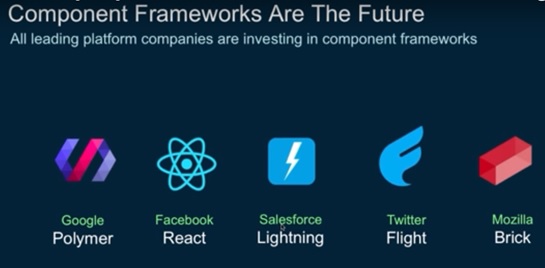- What
is Salesforce lightning component framework?
The Lightning Component
framework is a UI framework for developing dynamic web apps for mobile and
desktop devices.
2. What are the different component framework ?
3. Why Component Framework is future?
Re-Usability
Responsiveness
Event - Driven
Approach
Highly extensible
& Customizable
Highly interactive and
immersive experiences possible with lightning
4. Visualforce Components already available for reusability so why do
we need lightning components?
we need lightning components?
Lightning Component framework enforces
developers to break application into components.Where as VF does not.
Visualforce components are page-centric and most of the work is
done on the server. Lightning is designed from the component up, rather than having the concept of a page as its fundamental unit.Lightning Components are client-side centric,
which makes them more dynamic and mobile-friendly
5. Lightning VS Visualforce ?
Lightning Component Framework
|
Visualforce
|
App Centric
|
Page Centric
|
Lightning,
on the other hand, is a modern UI framework used in the development of
dynamic web apps for desktop and mobile devices.
|
Visualforce
enables developers to build custom user interfaces with a native hosting on
the Force.com platform
|
It is responsive,
If
you are developing for a Salesforce1 mobile app, you should prefer Lightning
framework
|
If
you want to create a page-centric experience with limited client-side logic,
you must opt Visualforce framework.
|
UI
Generation :
Client-Side(Javascript)
|
UI
Generation : Server-Side
|
Organizations
that can’t use Apex code can’t use Lightning Components
|
Organizations
that can’t use Apex code Still they can use Visualforce.
|
These
applications are generally referred to as single-page applications, or SPAs,
and are often built using third-party frameworks like AngularJS or React.
|
Visualforce
provides the facility for delivering template-driven web pages and email
messages
|
6. Single Page Application?
7. Lightning component architecture?
8. What is Aura in Salesforce Lightning?
Aura is the open source technology that powers Lightning
Components. The aura: namespace contains all of the basic building blocks for
defining components and applications.
<aura:attribute/>
<aura:iteration/>
9. What is the use of annotation ‘@AuraEnabled’ ?
Only the methods/properties
enabled with this annotation are accessible in lightning.
@AuraEnabled
public static
List<Contact> GetContactList()
{
List<Contact> contList = [Select Id,FirstName,Email
From Contact];
return contList ;
}
10. Explain the Lightning Component Configuration ?
Type
|
Interface Reference
|
Details
|
Lightning
Tab
|
force:appHostable
|
Interface
indicates the component can be
1.Hosted
in the Salesforce1 Mobile app
2.Component available as a
custom tab.
|
Lightning
Page
|
flexipage:availableForAllPageTypes
|
A
global interface that makes a component available in the Lightning App
Builder, and for any type of Lightning page.
|
Lightning
Record Page
|
flexipage:availableForRecordHome
|
If
your component is designed only for record pages, implement the flexipage:availableForRecordHome
interface instead of flexipage:availableForAllPageTypes
|
Lightning
Record Page
|
force:hasRecordId
|
Interface indicates the current record Id
should be injected in the component’s recordId attribute
<aura:attribute
name="recordId" type="Id" />
|
Lightning
Communities Page
|
forceCommunity:availableForAllPageTypes
|
To
appear in the Community Builder, a component must implement this interface
|
Lightning
Quick Action
|
force:lightningQuickAction
|
Interface
to a Lightning component to enable it to be used as a custom action in
Lightning Experience or the Salesforce mobile app.
|
11. What is lightning component bundle ?
A bundle
is sort of like a folder. It groups the related resources for a single
component
Resource
|
Details
|
Component
|
Contains
markup for the component or app
|
Controller
|
Contains
client-side controller methods to handle events in the component.
|
Helper
|
JavaScript
functions that can be called from any JavaScript code in a component’s bundle
|
Style
|
Contains
styles for the component.
|
Documentation
|
Provide Component
Documentation
|
Renderer
|
Client-side
renderer to override default rendering for a component.
|
Design
|
Design attribute is a
configuration for admin.
Anything wanted to
expose to admin to enter that attribute can be made as design attribute.
|
SVG
|
Custom
icon resource for components used in the Lightning App Builder or Community
Builder.
|
12. What is attribute in lightning component?
It’s like variable
declaration in Apex,Here we can store data received from Apex to the lightning
attributes.
<aura:attribute
name="listAccount" type="Account[]"/>
<aura:attribute
name="Name" type="String]"/>
13. What is “v” , “c”,”$A” in lightning coding?
Name
|
Details
|
Example
|
v
|
v
refers to view
|
var strClaimStatus =
component.get("v.Name");
|
c
|
c
refers to controller.
|
var
getContDistribution = component.get("c.GetDocAndFormList");
|
$A
|
Its
top level namespace for
creation of components, getting a component, setting a component, Enqueuing
Action, Running an Action
|
$A.enqueueAction(getContDistribution);
|
14. How to debug the lightning component ?
console.log(JSON.stringify(response.getReturnValue()));
15. How to test the lightning components ?
After you create a
component, you will want to display it somewhere. There are a number of
possibilities.
Standalone Lightning app: Create a standalone Lightning app (e.g.
myapp.app) and include your component in this app. Access your Lightning app by
URL.
Lightning Experience: Display your component in the Lightning
Experience using the App Builder. You can edit the home page, edit a record
detail page or create/edit a new app page to include it. Alternatively, you can
create a custom Lightning tab that references your component and add that tab
to your Lightning navigation.
Salesforce1 Mobile app: Display your component in the Salesforce1
Mobile app by creating a custom Lightning tab that references it and adding
that tab in your mobile navigation.
Template-based community: Display your component
in your template-based (e.g. Napili) community using the Community Builder.


